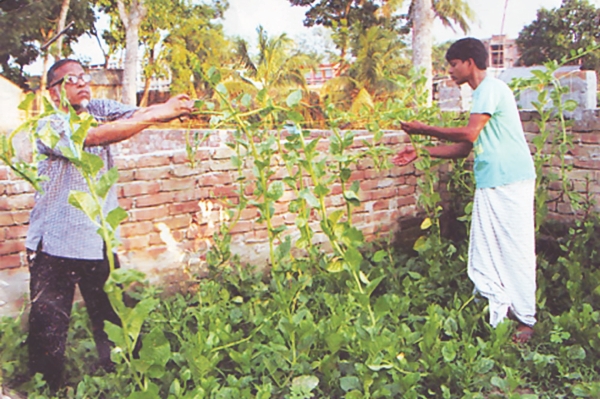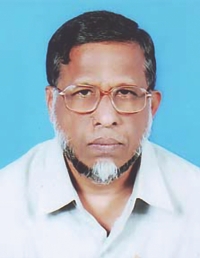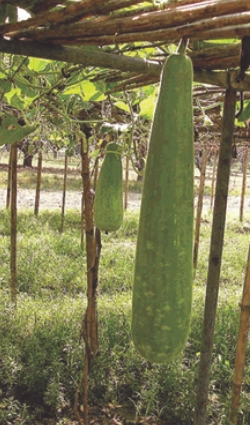| Cover Story

Pabna
Double Decker Farming
This ingenious method of cultivation devised and implemented by Zafar Sadeque directly increases 25 percent use of land. This article brings to light as to how the farming method was introduced and how it has helped people like Md. Mukter.
..............................................................................................................
Ahmed Humayun Kabir Topu
 |
Prof. Zafar Sadeque |
Md. Mukter is a fishmonger by original trade. After being inspired and motivated my Agriculturist Zafar Sadeque, he now is a farmer as well. But, his farming methods are different; one can say they are a level higher than the normal day-to-day farmer. Mukter has applied the Two-Level Agriculture technology on his three Kathas of land.
Mukter started off on March 13, 2011 after Zafar had paid him a visit. He sowed seeds of Indian Spinach, and made four bamboo structures to hold the upper level from the ground. The structures were very specific in design and orientation of placement for maximum yield of the crop on both levels. The first harvest from the ground was gathered on May 7, 2011, and from the upper level on June 6, 2011. Production of the crop kept fetching yield till July 4, 2011, and stood at a whopping 390 kg, of which 71 kg came from the top level of the cultivation. Total production had increased by 22% bringing the net income up to Tk. 3,900/= from a base investment of only Tk. 700/=. His wife Momtaj Begum and HSC candidates Md. Rubel Hossain and Kajali Akter Bristy of Shahid Monsur Ali Degree College had extended their helping hands to Mukter in making this ordeal a success. They are all expectant of farmers all around to adopt this method as agriculturally rich land is on the decline in terms of availability.
Md. Zafar Sadeque is an assistant professor of Agriculture Studies of Atghoria College, Pabna. After his two years experiment with his brother Abdullah Sadek, in different areas in northern districts, he presented the possibility of success of this new method of agriculture. Blending the sciences of Agronomy and Astronomy, Professor Sadeque launched his experiments with mathematical calculations and found success of the method.
He claims, “An agronomical clue led to a solution: a minimum of eight hours of exposure to sunlight for a plant is enough for it to produce food for itself for the next 24 hours. So, utilization of renewable natural resources like sunlight would be the solution. Two-level agriculture could be a strong instrument for increasing productivity of gradually decreasing cultivable land for the food security for 130 million rural people of Bangladesh. The new technique will increase land use directly to the tune of 25%. Two-level Agriculture in the long-run will ensure food-security of Bangladesh.”
Based on the clue of minimum requirement of eight hours of exposure to sunlight for a plant, a study was conducted from May, 2008 to June 2009 to find out the following:
(a) The exact minimum and optimum distance to be maintained in between two frames to ensure that the plants on the ground as base crops are exposed to a minimum eight hour sunlight exposure each day throughout the year.
(b) The exact height of the frame from the ground that will be most suitable for transgression of the shadow to ensure minimum eight hours of exposure to sunlight for the plants on the ground, and also at the same time convenient for the farmer to perform intercultural operation of the creeper that will be on the frame as cover crop.
 From the study, it was revealed that; From the study, it was revealed that;
(i) The exact direction and size of the frames should be precisely geographically North-South, and the width of the platform of the frames must be four feet in dimension.
(ii) The exact height of the frames from the ground must be five feet.
(iii) The exact minimum and optimum distance to be maintained between two frames should not be any less than 13 feet.
(iv) Additionally, it was further revealed that the height of the base crop should preferably not exceed 2 feet 6 inches in height to ensure that the transgression of the shadow created by the top frames maintain a minimum of eight hours exposure of sunlight to the base crop.
This method can be used with two different types of crops for cultivation also. Rice, Wheat, Barley, Sesamum, Mustard, Lentil, Gram, Pea, Potato, Brinjal, Tomato, Corriander, Data, Spinach, Radish, Cauliflower, Cabbage, Knolkhol, Beet, Leafy vegetable, Corriander leaf, Chilli, Arum and Sweet potato may be cultivated as base crops, while creeping type of vegetables like Bottle gourd, White gourd, Cucumber, Potol, Bitter gourd, Rib gourd, Snake gourd, Bean, Yard long bean can be cultivated as cover crops.
Professor Zafar Sadeque along with his younger brother Abdullah Sadek, a world bank consultant, conducted three practical experiments in Pabna and Naogaon districts from 2009 to 2010 and had perfected the innovative method.
Experiment 1, March 2009 to August 2009: Chili on the ground and Potol on the frame.
The first practical experiment was conducted on 4.86 katha of land belonging to Md. Rowshan Ali of the village Tetulia from Dhopadaha Union of Santhia Upazilla under Pabna district. The experiment used chili as the base crop and Potol as the cover crop. Yield was satisfactory for both the crops and the base crop was not at all hampered due to shadow resulting from cover crop on the frame.
Experiment 2, January 2010 to June 2010: IRRI-Boro Rice as base crop under partial shadow of frame.
Place of cultivation: 6.5 katha of land in Bankai village from Dhamai Nagar Union of Raiganj Upazilla under Sirajganj district. Five frames were made with length of 50-55 feet placed in a North-South geographical orientation. Miniket rice was cultivated with no cover crop. Rice seedlings were transplanted on February 26, 2010, and harvested on May 6, 2010. The yield was considered as normal.
Experiment 3, November 2009 to June 2010: IRRI- Boro as base crop and Bottle gourd as cover crop.
This experiment was conducted with full patronization of Dr Akram H Chowdhury, a lawmaker from Nogaon-3 (Mahadevpur- Badalgachi). From his own interest, Zafar Sadeque took upon seven kathas of land belonging to Dinesh Sing from Dangishara village of Badalgachi Upazilla in Nogoan district, and beard all the costs. He had used BR-28 variety of rice on the ground as base crop and Bottle-gourd was cultivated on the frames as the cover crop. Rice seedlings were transplanted on February 8, 2010 and harvested on May 12, 2010. A total yield of eight maunds of rice was cultivated from the seven kathas of land which stands at 23 maunds per bigha. The cover crop yield brought a harvest of 215 Bottle-gourds from the same plot of land which would amount to 600 Bottle-gourds per bigha.
Professor Sadeque expressed a few positive impacts that are evident from the experiments:
* The frames occupy 25% of the land, thus from the utilization point of view cultivable land of Bangladesh will increase by 25% directly (except forests, hills and water-bodies). It should be kept in mind that Bangladesh is loosing 1.18% cultivable land each year which is 220 hectares per day.
* Additional vegetable can be produced on the frames as cover crops alongside rice on the ground as base crops ensuring “rice and curry” from the same plot simultaneously.
* Supply of vegetables can be increased if this method is employed, and with increased supplies the prices will be reduced.
* The National economy will be strengthened due to flourishing rural agro economy from increasing production of vegetables along with the main crops resulting in additional income generation of the farmers through adopting 'Two-level Agriculture'.
* This method can be developed as a supplementary way of agricultural production and will create opportunities of further expansion with related farming on the lands, in trade and in agro-processing exercises.
* The scope of instigating the method also does not require much capital to start off with and no additional capital or foreign currency is needed.
* This method is not labor-intensive, as both crops are produced simultaneously on the same land. Farmers in this retrospect need not employ extra labor.
Professor Sadeque claimed: if the two level cultivation method was applied on 82.90 lakh hectors of total cultivable land in Bangladesh, and 25 percent of it was covered with the frames, then over 3 billion US dollars worth of additional crops could be produced annually. Professor Sadeque's younger brother Abdullah Sadeque, a former consultant of the World Bank, jointly conducted the experiments. They are now seeking the government's support for developing the new method. “We have already submitted a project plan to the agriculture ministry and it is yet to be approved. If the government takes the step, the best use of lands by cultivating multi-crops simultaneously will definitely help in strengthening the economy. The government's attention, in its highest echelons, is necessary for it to happen”, said Prof. Zafar Sadeque.

Prof. Zafar Sadeque's two level gourd cultivation
Copyright
(R) thedailystar.net 2011
|




